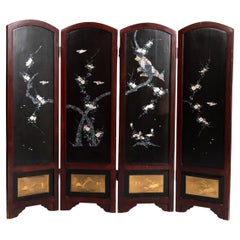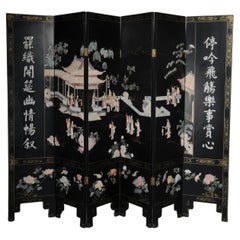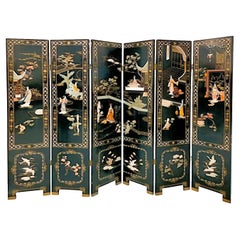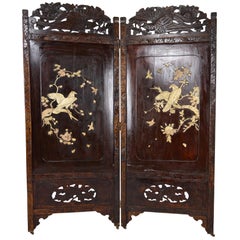Japanese Inlay Screen
19th Century Shibayama Four Panel Screen Meiji Period Japan, C.1880
Located in London, GB
19th century Shibayama four Panel screen Meiji Period Japan C.1880
Mother of pearl inlay in
Category
Antique 19th Century Japanese Meiji Paintings and Screens
Materials
Mother-of-Pearl, Wood, Lacquer
Exclusive Japanese screen/room divider made of black lacquer, painted and inlaid
Located in Berlin, DE
Exclusive Japanese screen/room divider made of black lacquer, painted and inlaid
Carved in wood
Category
20th Century Japanese Screens and Room Dividers
Materials
Stone, Quartz
H 72.45 in W 96.46 in D 0.79 in
Elegant Six-Panel Japanese Screen, 1920s
Located in Cesena, FC
Elegant Six-Panel Japanese Screen, 1920s
Fascinating 1920s screen with details of fine Japanese workmanship. The screen, composed of six lacquered panels, rests on bracket feet with...
Category
Vintage 1910s Japanese Screens and Room Dividers
Materials
Brass
Recent Sales
Edo Period Rare Superb Japanese Lacquer Screen with Hardstone Inlay
Located in West Palm Beach, FL
period Japanese five-panel lacquer and Luxurious Stone screen decorated with a view of various birds
Category
Antique 19th Century Japanese Japonisme Screens and Room Dividers
Shibayama Inlaid & Carved Folding Screen, "Eagles", Japan, Meiji Era, circa 1890
Located in L'Etang, FR
Folding screen / room divider.
In carved, inlaid and lacquered wood.
Carved with birds and
Category
Antique 1890s Japanese Meiji Screens and Room Dividers
Materials
Bone, Wood
H 69.69 in W 56.7 in D 1.19 in
Japanese Meiji period (1868-1912) Damascene Table Screen by Masamitsu
Located in Newark, England
– 2.81)
From our Japanese collection, we are delighted to introduce this Japanese Damascene Table Screen
Category
Antique Early 1900s Japanese Meiji Metalwork
Materials
Gold, Gold Plate, Silver, Brass
Japanese Lacquered Fire Screen
Located in Wilson, NC
Japanese lacquered fire screen has a dark red lacquer background with floral borders around a
Category
Early 20th Century Japanese Screens and Room Dividers
Materials
Mother-of-Pearl, Wood, Paint
Carved and Inlaid Shibayama Folding Screen, Japan, Meiji Era, circa 1890
Located in VÉZELAY, FR
animal marquetry) and painted on the back side (flowers).
Shibayama style, Japan, Meiji era, around
Category
Antique 1890s Japanese Meiji Screens and Room Dividers
Materials
Wood
H 71.66 in W 55.91 in D 1.19 in
Goldfish Japanese Lacquer Screen
Located in Los Angeles, CA
Six panel Japanese lacquer folding screen with Tosakin goldfish & coral motif on front side with
Category
Vintage 1920s Japanese Chinoiserie Paintings and Screens
Materials
Bronze
People Also Browsed
Meiji Era Japanese Two Panel Hand Painted Wood Table Screen Tale of Genji
Located in Studio City, CA
A Meiji era Japanese two-panel wood screen, with illustrated images from The Tale of Genji that are exquisitely painted directly on wood with fine detail and precision, accented with...
Category
Antique 19th Century Japanese Meiji Paintings and Screens
Materials
Gold Leaf
H 15.75 in W 26 in D 0.5 in
FINE ANTIQUE ROOM DIVIDER TITLED IN CHINESE "MIDSUMMER PAiNTING OF XINWEI YEAR"
Located in West Sussex, Pulborough
We are delighted to offer for sale this stunning hand made Oriental black lacquered and hand painted Chinese full sized room divider titled in Chinese "Midsummer Painting of Xinwei Y...
Category
Vintage 1920s Chinese Chinoiserie Screens and Room Dividers
Materials
Lacquer
H 71.07 in W 71.66 in D 1.19 in
Early 20th Century Japanese Cherry Blossom Screen by Kano Sanrakuki
Located in Kyoto, JP
Cherry Blossoms
Kano Sanrakuki (1898-1981)
Showa period, circa 1930
2-panel Japanese Screen
Color, gofun and gold leaf on paper
Against a backdrop of gold-leafed groun...
Category
Early 20th Century Japanese Showa Paintings and Screens
Materials
Gold Leaf
19th Century Japanese Edo Screen Kano School Garden Terrace
Located in Rio Vista, CA
Fantastic 19th century Japanese Edo/Tokugawa period two-panel byobu screen featuring Chinese children frolicking on a garden terrace with a pavilion and large pine tree. Made in the ...
Category
Antique 19th Century Japanese Edo Paintings and Screens
Materials
Brass, Gold Leaf
Japanese Two-Panel Screen: Ink Landscape on Silk
By Shunyu
Located in Hudson, NY
Japanese Two Panel Screen: Ink Landscape on Silk, Meiji period (1868 - 1912) painting of a man riding a mule on a pathway through the Kurotani mountains with a thatched roof shelter ...
Category
Antique 19th Century Japanese Meiji Paintings and Screens
Materials
Silk, Wood
Japanese Byobu - Six Panel Japanese Screen
By Japanese Studio
Located in Brescia, IT
This 18th century "Kano school" six-panel screen is truly special. The author is unknown, but his singular genius in portraying these cranes near the water creates an emotion that ca...
Category
Antique Late 18th Century Japanese Edo Paintings and Screens
Materials
Paper
Japanese Four Panel Screen, Autumn Flowers
Located in Hudson, NY
Taisho period painting (1912-1926) of a fall landscape with wild grasses, red maple, and dahlias. Mineral pigments on gold with a silk brocade border and beautiful metal mounts.
Category
Vintage 1920s Japanese Taisho Paintings and Screens
Materials
Wood, Paper, Silk
Japanese Folding Screen Six Panels Painted on Gold Leaf
By Japanese Studio
Located in Brescia, IT
Paravento a sei pannelli di scuola giapponese Kano: paesaggio con bellissime ed eleganti gru vicino al fiume, con alberi di pino e sakura.
Dipinto a mano con pigmenti minerali ed inc...
Category
Antique Early 19th Century Japanese Edo Paintings and Screens
Materials
Gold Leaf
Japanese Byobu - Japanese Folding Screen Gold Leaf
By Japanese Studio
Located in Brescia, IT
Floral scene of a "Rimpa School" garden with polychrome chrysanthemum flowers.
Six-panel screen painted with pigments on golden rice paper of good size and well preserved.
Bold color...
Category
Antique Early 19th Century Japanese Edo Paintings and Screens
Materials
Gold Leaf
Circa 1700 Japanese Screen Pair, Cranes & Pines, Kyoto Kano School
Located in Kyoto, JP
Pines and Cranes
Anonymous. Kyoto Kano School.
Late 17th/early 18th centuries, circa 1700.
Pair of six-panel Japanese folding screens.
Ink, gofun, pigment and gold leaf on ...
Category
Antique Late 17th Century Japanese Edo Paintings and Screens
Materials
Gold Leaf
Meiji Era, Circa 1900 Japanese Screen Pair, Flowers & Birds of Spring & Autumn
Located in Kyoto, JP
Flowers & Birds of Spring and Autumn
Unknown artist.
Japan. Meiji period, circa 1900.
A pair of six-fold screens. Ink, color, gofun and gold leaf on paper.
Signed: Gaga S...
Category
Antique 1890s Japanese Meiji Paintings and Screens
Materials
Gold Leaf
H 68 in W 148 in D 0.75 in
Pair of 19th Century Japanese Screens
Located in Bagshot, GB
A pair of large 19th century Japanses Screens of Japanese scenery.
The screens also come with a wooden crate which would have been built for them at a later date in order to move ...
Category
Antique 19th Century Asian Other Decorative Art
Materials
Paper
Japanese Screen of Spring on Gold Leaf
Located in Brescia, IT
It is a two-panel screen from the Taisho period, around 1920, beautifully painted in excellent detail.
The best of Rinpa's school painting: large empty space that highlights a pair ...
Category
Early 20th Century Japanese Taisho Paintings and Screens
Materials
Gold Leaf
18th Century Five-Panel Chinese Coromandel Screel
Located in CABA, AR
Transport yourself back to the opulent splendor of the 18th century with this magnificent Chinese five-panel black Coromandel screen, a true masterpiece of artistic and cultural her...
Category
Antique 18th Century Chinese Chinese Export Paintings and Screens
Materials
Gold Leaf
Antique Japanese Meiji Period Silk Embroidered Screen Room Divider Byobu C.1900
Located in London, GB
Antique Japanese Meiji period silk embroidered screen /room divider Byobu C.1900 Kyoto, Japan.
Silk embroidered satin lacquer framed panels.
Late 19th century - early 20th century ...
Category
Antique Early 1900s Japanese Meiji Paintings and Screens
Materials
Silk, Lacquer
H 67.33 in W 88.98 in D 0.79 in
Six-Panel Japanese Screen on Spring Gold Leaf
Located in Brescia, IT
Spring landscape by an unknown painter of the Rinpa school, 19th century, six-panel ink painted on gold leaf on rice paper.
The flowers are made with the "gofun" technique, natural ...
Category
Antique Late 19th Century Japanese Edo Paintings and Screens
Materials
Gold Leaf
Get Updated with New Arrivals
Save "Japanese Inlay Screen", and we’ll notify you when there are new listings in this category.
Japanese Inlay Screen For Sale on 1stDibs
At 1stDibs, there are many versions of the ideal Japanese inlay screen for your home. Each Japanese inlay screen for sale was constructed with extraordinary care, often using metal, wood and lacquer. Your living room may not be complete without a Japanese inlay screen — find older editions for sale from the 18th Century and newer versions made as recently as the 20th Century. Each Japanese inlay screen bearing mid-century modern, modern or Victorian hallmarks is very popular. You’ll likely find more than one Japanese inlay screen that is appealing in its simplicity, but Frank Faulkner produced versions that are worth a look.
How Much is a Japanese Inlay Screen?
Prices for a Japanese inlay screen can differ depending upon size, time period and other attributes — at 1stDibs, they begin at $795 and can go as high as $22,500, while the average can fetch as much as $4,441.
Questions About Japanese Inlay Screen
- 1stDibs ExpertAugust 17, 2021Japanese screens are called Byōbu and are made from many panels with beautiful calligraphy and paintings. These folding screens can be a decorative and interesting way to separate rooms in a living space. Find a collection of Japanese screens for sale on 1stDibs.
- 1stDibs ExpertApril 5, 2022Japanese screen painting is the art of creating byōbu, or Japanese screens. Byōbu vary in subject matter and style. The screens are free-standing, portable and decorated with symbolic images or calligraphy. It is common to find byōbu in pairs with at least two panels. Shop a selection of byōbu on 1stDibs.
 Lotus GalleryMarch 17, 2021A Japanese low screen was traditionally used while seated upon the floor. The low screen would block wind and drafts, provide limited privacy, and are often decorated with seasonal themes.
Lotus GalleryMarch 17, 2021A Japanese low screen was traditionally used while seated upon the floor. The low screen would block wind and drafts, provide limited privacy, and are often decorated with seasonal themes.




